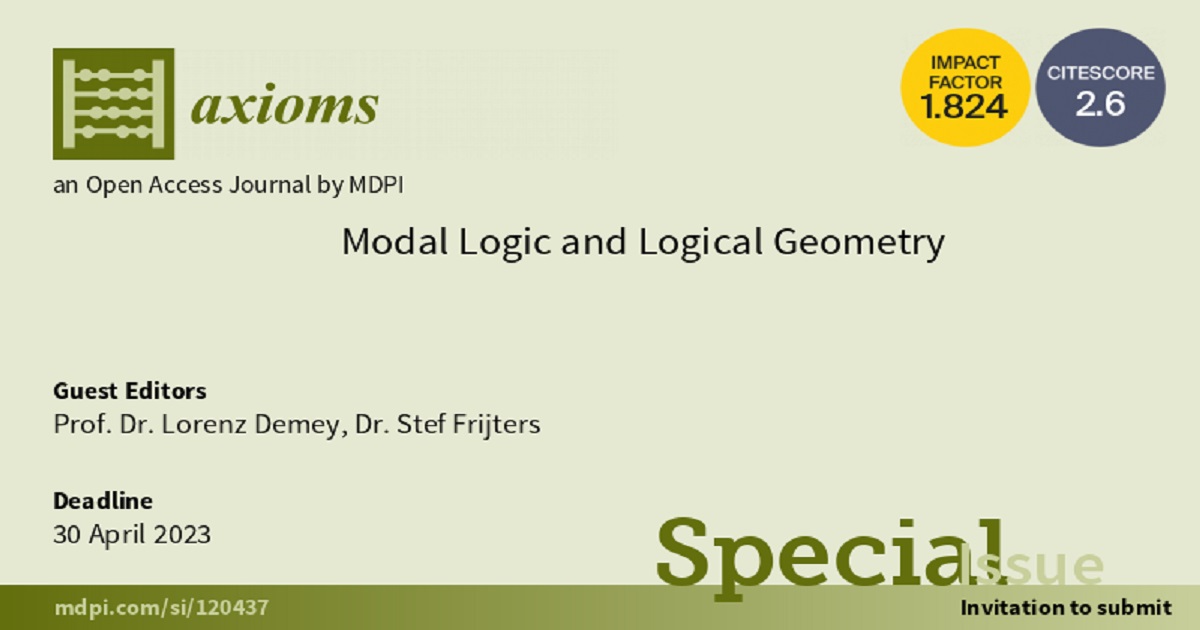Modal Logic and Logical Geometry
A special issue of Axioms (ISSN 2075-1680). This special issue belongs to the section "Logic".
Deadline for manuscript submissions: closed (30 April 2023) | Viewed by 11178

Special Issue Editors
Interests: logical geometry; modal logic; history of logic; epistemic logic
Special Issue Information
Dear Colleagues,
The area of modal logic and the toolkit of Aristotelian diagrams (e.g., the square of opposition) have a long history in philosophy, and nowadays they are also intensively studied in computer science, mathematics, linguistics, etc. Modal logic has traditionally been concerned with modal notions such as necessity, possibility and contingency, and today, it encompasses various other notions, such as knowledge, obligation, action, etc. Aristotelian diagrams, such as the square of opposition, were traditionally used as a mnemotechnic tool to teach syllogistics, and today, they are frequently used in various areas of logic research. Over the past decade, it has become increasingly clear that these diagrams can be fruitfully studied as objects of independent interest, which has given rise to the burgeoning research program of logical geometry.
Modal logic and logical geometry enjoy a deep and many-faceted connection. On the one hand, modal logic has yielded some of the most interesting Aristotelian diagrams known to date, e.g., John Buridan’s 14th-century octagon of opposition for de re modal statements. On the other hand, many of the relations studied in logical geometry are themselves thoroughly modal in nature, e.g., the condition that two statements cannot be true together, which is used to define the relations of contrariety and contradiction.
This Special Issue aims to provide a platform for further exploration along these lines. It will be devoted to state-of-the-art research on modal logic, logical geometry, and especially, their interaction. Both ‘modal logic’ and ‘logical geometry’ are understood in a broad sense, as should be clear from the following non-exhaustive list of topics:
modal logic; epistemic logic; doxastic logic; STIT logic; dynamic logic; temporal logic; hybrid logic; term-modal logic; relational semantics; topological semantics; logical geometry; square of opposition; hexagon of opposition; Aristotelian diagram; historical case studies; bitstring semantics; Aristotelian isomorphism; category theory; existential import; combinatorial semantics; logic-sensitivity.
Contributions may be submitted on a continuous basis before the deadline. After peer review, submissions will be selected for publication based on their quality and relevance.
Prof. Dr. Lorenz Demey
Dr. Stef Frijters
Guest Editors
Manuscript Submission Information
Manuscripts should be submitted online at www.mdpi.com by registering and logging in to this website. Once you are registered, click here to go to the submission form. Manuscripts can be submitted until the deadline. All submissions that pass pre-check are peer-reviewed. Accepted papers will be published continuously in the journal (as soon as accepted) and will be listed together on the special issue website. Research articles, review articles as well as short communications are invited. For planned papers, a title and short abstract (about 100 words) can be sent to the Editorial Office for announcement on this website.
Submitted manuscripts should not have been published previously, nor be under consideration for publication elsewhere (except conference proceedings papers). All manuscripts are thoroughly refereed through a single-blind peer-review process. A guide for authors and other relevant information for submission of manuscripts is available on the Instructions for Authors page. Axioms is an international peer-reviewed open access monthly journal published by MDPI.
Please visit the Instructions for Authors page before submitting a manuscript. The Article Processing Charge (APC) for publication in this open access journal is 2400 CHF (Swiss Francs). Submitted papers should be well formatted and use good English. Authors may use MDPI's English editing service prior to publication or during author revisions.
Keywords
- logical geometry
- modal logic
- square of opposition
- bitstring semantics
- negation
Benefits of Publishing in a Special Issue
- Ease of navigation: Grouping papers by topic helps scholars navigate broad scope journals more efficiently.
- Greater discoverability: Special Issues support the reach and impact of scientific research. Articles in Special Issues are more discoverable and cited more frequently.
- Expansion of research network: Special Issues facilitate connections among authors, fostering scientific collaborations.
- External promotion: Articles in Special Issues are often promoted through the journal's social media, increasing their visibility.
- e-Book format: Special Issues with more than 10 articles can be published as dedicated e-books, ensuring wide and rapid dissemination.
Further information on MDPI's Special Issue polices can be found here.




